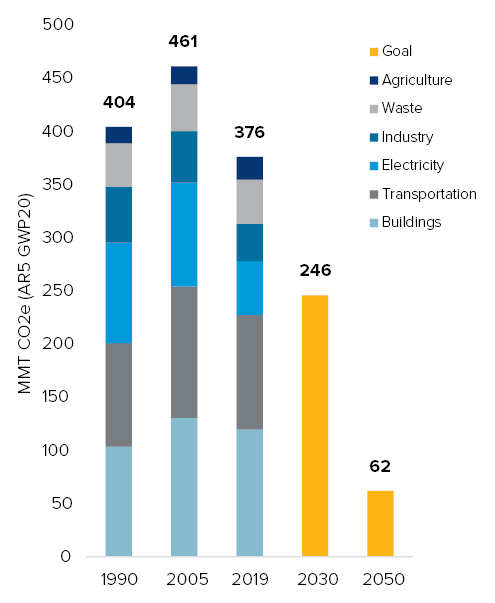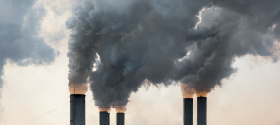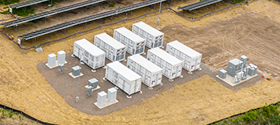Greenhouse Gas Emissions Reduction
Leading the Way on Climate Action
The Climate Act requires New York to reduce economy-wide GHG emissions 40% by 2030 and 85% by 2050 from 1990 levels.
Reducing greenhouse gas (GHG) emissions, such as carbon dioxide and methane, is essential to combatting climate change and creating cleaner, healthier communities.
More than half of New York’s GHG emissions come from buildings and transportation, while other leading emissions sources include power generation, waste, industry, and agriculture.
The Climate Act sets nation-leading limits on emissions that will enable the State to advance economy-wide carbon neutrality – a balance between how much carbon we emit and how much can be absorbed from the atmosphere. The Climate Action Council’s Final Scoping Plan ![]() , which was approved in December 2022, charts the course for New York State’s policies and programs to achieve swift, transformative changes to our energy systems and economy.
, which was approved in December 2022, charts the course for New York State’s policies and programs to achieve swift, transformative changes to our energy systems and economy.
How We’re Driving Emissions Reduction to Decarbonize New York
Meeting our emissions reduction targets requires decarbonizing New York’s buildings, transportation system, and power generation. In other words, decarbonization requires transitioning from equipment and energy systems that involve the combustion of fossil fuels, including oil, propane, and natural gas, to zero-emission technologies and renewable energy sources. New York’s transition away from fossil fuels is already underway. We’re continually expanding our supply of solar and wind energy, as well as increasing adoption of electric vehicles and heat pumps.
NYSERDA is working with other State agencies, utilities, industry, and community partners to accelerate New York’s work towards achieving our GHG emissions reduction goals while establishing a model for other states and jurisdictions to follow.
Here's how:
- As a Climate Action Council Co-Chair, NYSERDA is helping implement the roadmap of policies and recommendations to achieve the Climate Act’s goals under the Scoping Plan.
- Guiding and facilitating State Energy Plan
 development and shaping New York energy policies by catalyzing market transformation and through development and implementation of mandates and Executive Orders.
development and shaping New York energy policies by catalyzing market transformation and through development and implementation of mandates and Executive Orders. - Identifying and implement strategies for energy, buildings, and transportation sector emissions reductions and other GHG mitigation strategies.
- Supporting development of statewide GHG inventory, supporting the Department of Environmental Conservation (DEC) in updated emissions methodology rulemaking and implementation.
- Facilitating State agencies’ efforts to lead by example
 in reducing and eliminating emissions from their operations.
in reducing and eliminating emissions from their operations. - Beginning design of a cap-and-invest program
 that sets an annual cap on the amount of pollution that is permitted to be emitted in New York. Implementation will follow the guiding principles of affordability, climate leadership, creating jobs and preserving competitiveness, investing in Disadvantaged Communities, and funding a sustainable future.
that sets an annual cap on the amount of pollution that is permitted to be emitted in New York. Implementation will follow the guiding principles of affordability, climate leadership, creating jobs and preserving competitiveness, investing in Disadvantaged Communities, and funding a sustainable future.
Achieving Economy-wide Carbon Neutrality
Our emissions reduction efforts will drive New York’s clean energy economy and improve local air quality while contributing to global efforts to mitigate climate change. Nearly half a million New Yorkers will be employed in clean energy to develop the renewable energy systems and equipment needed in New York, as well as other jurisdictions.
The transition to carbon neutrality will also transform our homes, transportation, and infrastructure. By 2030, home energy efficiency upgrades will make heat pumps the preferred option for customers, with two million homes having already switched to clean heating and cooling. Millions of electric vehicles will be on the road in New York by 2030 and charged by a grid that sources 70% or more of its electricity from renewable sources.
New York will generate 100% zero-emission electricity by 2040, which will power the vast majority of our buildings and modes of transportation. To achieve an 85% emissions reduction by 2050, future research and development will provide low-carbon solutions for hard-to-electrify sectors and negative emissions technology to capture and sequester carbon.


New York continues to make progress toward the goal of an 85% greenhouse gas emissions reduction relative to the 1990 baseline by 2050.
Our Progress
Established by the Climate Act ![]() , our nation-leading climate goals set firm limits on GHG emissions. Using 1990 as a benchmark, New York is striving to reduce GHG emissions 40% by 2030 and 85% by 2050. NYSERDA will work with DEC to continually monitor progress towards our goals through the statewide greenhouse gas inventory report
, our nation-leading climate goals set firm limits on GHG emissions. Using 1990 as a benchmark, New York is striving to reduce GHG emissions 40% by 2030 and 85% by 2050. NYSERDA will work with DEC to continually monitor progress towards our goals through the statewide greenhouse gas inventory report ![]() .
.
While we work towards our statewide emissions reduction goals, interim progress will also be assessed by the number of homes that convert to clean heating and cooling and the portion of new vehicle sales that are zero-emission. Similarly, the number of businesses that align their mission with sustainability and the total job growth in clean energy are key measures of our progress towards the 2030 and 2050 targets.
Advancements in innovation are also paramount to our climate action and emissions reduction. Developing negative emissions technologies and solutions to sequester carbon from construction and industry may be necessary to achieve carbon neutrality.
Other indicators of our progress can be found on New York’s Clean Energy Dashboard.
GHG Emissions Reduction Programs and Initiatives
-

Regional Greenhouse Gas Initiative (RGGI)
Read MoreAssigns a price to power plant emission and directs revenue to New York’s clean energy initiatives.
Read more about Regional Greenhouse Gas Initiative (RGGI)
-

Clean Energy Communities
Read MoreProvides support, recognition, and grant funding for municipalities that take action to reduce emissions and advance clean energy in their communities.
Read more about Clean Energy Communities
-

Innovation
Read MoreSupports cleantech businesses to accelerate the time to market for innovative clean energy technologies.
Read more about Innovation
-

NY Truck Voucher Incentive
Read MoreOffers vouchers and discounts for fleets to purchase or lease of zero-emission trucks and buses and take high-emitting, polluting diesel vehicles off the road.
Read more about NY Truck Voucher Incentive
-

Clean Transportation Prizes
Read MoreAwards funding for projects that electrify transportation, reduce air pollution, and enhance clean mobility in New York’s underserved communities.
Read more about Clean Transportation Prizes
-

Energy Storage
Read MoreServes a crucial role in reducing emissions by integrating clean energy into the grid, lowering the costs of meeting peak electricity demand, and increasing efficiency.
Read more about Energy Storage
Sign Up For News
Stay up-to-date on energy saving programs and incentives, best practices, and more
Stay Connected
